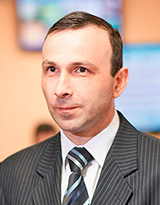Method for Determining the Number of Propellers in an Aircraft from a Radar Image Obtained by Inverse Synthesis of the Antenna Aperture
https://doi.org/10.35596/1729-7648-2024-22-5-53-61
Abstract
The inverse antenna aperture synthesis technology used to construct a radar image of an aircraft’s propellers has shown high efficiency. The radar image allows to visualize the blades of the rotors included in the functional group (traction rotors of an aircraft, rotors of a twin-rotor helicopter, rotors of a multicopter). In the case of a single rotor in an aircraft (an airplane’s tractor rotor, a single-rotor helicopter’s main rotor), the radar image is simple and clearly perceptible. In the case of several propellers belonging to the same functional group, the ana ysis of the radar image becomes significantly more complicated. This is due to the random relative position of the blades of different propellers at the moment the image begins to be constructed, as well as the possible random coincidence of the spatial position of the blades belonging to different propellers. In this regard, determining the number of propellers in an aircraft is a new urgent task, the solution of which allows us to obtain additional information for recognition. The method under consideration for determining the number of propellers is based on the most common design features – the blades in the propeller follow at the same angular interval, in the propellers of the functional group the number of blades is the same.
About the Authors
S. R. HeisterBelarus
Heister Sergey Romanovich, Dr. of. Sci. (Tech.), Professor, Chief Researcher
223050, Minsk Region, Minsk District, Borovlyansky S/S, Korolev Stan Village, Moscow St., 1а, room 17
Tel.: +375 29 760-86-71
V. V. Kirychenka
Belarus
Kirychenka V. V., Senior Researcher
References
1. Tait P. (2005) Introduction to Radar Target Recognition. USA, New York, Institution of Electrical Engineers.
2. Shirman Y. D. (2002) Computer Simulation of Aerial Target Radar Scattering: Detection, Recognition and Tracking. Boston-London, Artech House, Inc.
3. Jacobs S. P., O’Sullivan J. A. (2000) Automatic Target Recognition Using Sequences of High Resolution Radar Range-Profiles. IEEE Transactions on Aerospace and Electronic Systems. 36 (2), 364–381. DOI: 10.1109/7.845214.
4. Heister S. R. (2000) Adaptive Detection-Recognition with Noise Selection Based on Spectral Portraits. Minsk, Military Academy of the Republic of Belarus (in Russian).
5. Heister S. R., Parkhomenko N. G., Heister A. S. (2011) Spectral-Temporal Structure of Signals Reflected from Moving Ground Objects, in Application to Inverse Synthesis of the Antenna Aperture. Electromagnetic Waves and Electronic Systems. 16 (12), 27–33 (in Russian).
6. Heister S. R., Parkhomenko N. G., Heister A. S. (2011) Recognition and Measurement of the Length of Moving Objects in an Inverted Aperture Synthesis Radar. Electromagnetic Waves and Electronic Systems. 16 (11), 66–70 (in Russian).
7. Heister S. R., Nguyen T. T. (2018) Algorithms for Constructing a Radar Image of Propellers in the Horizontal and Vertical Planes of an Aircraft in a Radar Sensor with Inverted Antenna Aperture Synthesis. Doklady BGUIR. (5), 92–98 (in Russian).
8. Heister S. R., Nguyen T. T. (2019) A Method for Measuring the Repetition Rates of Aircraft Rotor Blades Based on Convolution of the “Secondary” Modulation Spectrum. Doklady BGUIR. (1), 68–74 (in Russian).
9. Heister S. R., Nguyen T. T. (2019) Experimental Studies of Algorithms for Constructing Radar Images of Propellers and a Method for Measuring Blade Repetition Rate. Doklady BGUIR. (4), 72–78 (in Russian).
Review
For citations:
Heister S.R., Kirychenka V.V. Method for Determining the Number of Propellers in an Aircraft from a Radar Image Obtained by Inverse Synthesis of the Antenna Aperture. Doklady BGUIR. 2024;22(5):53-61. (In Russ.) https://doi.org/10.35596/1729-7648-2024-22-5-53-61































